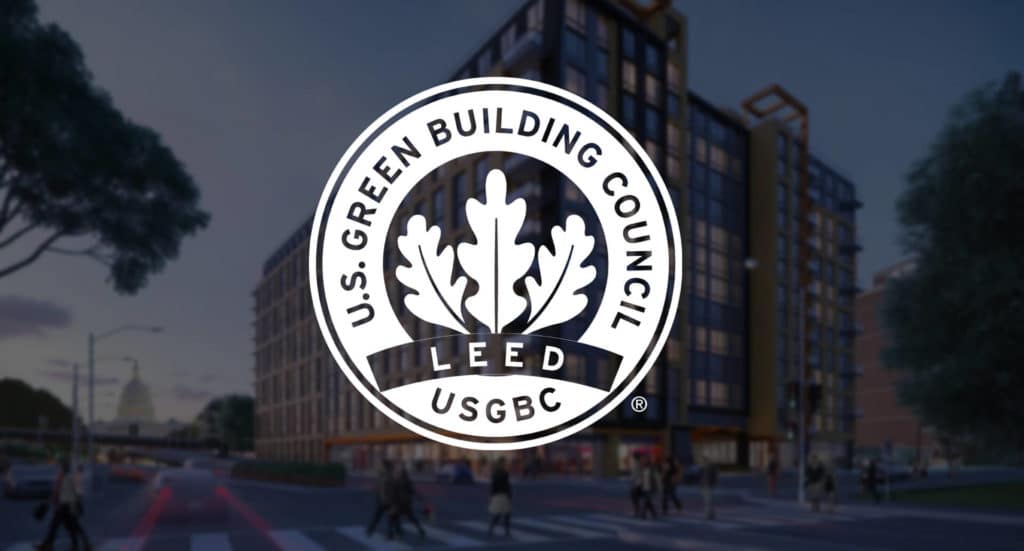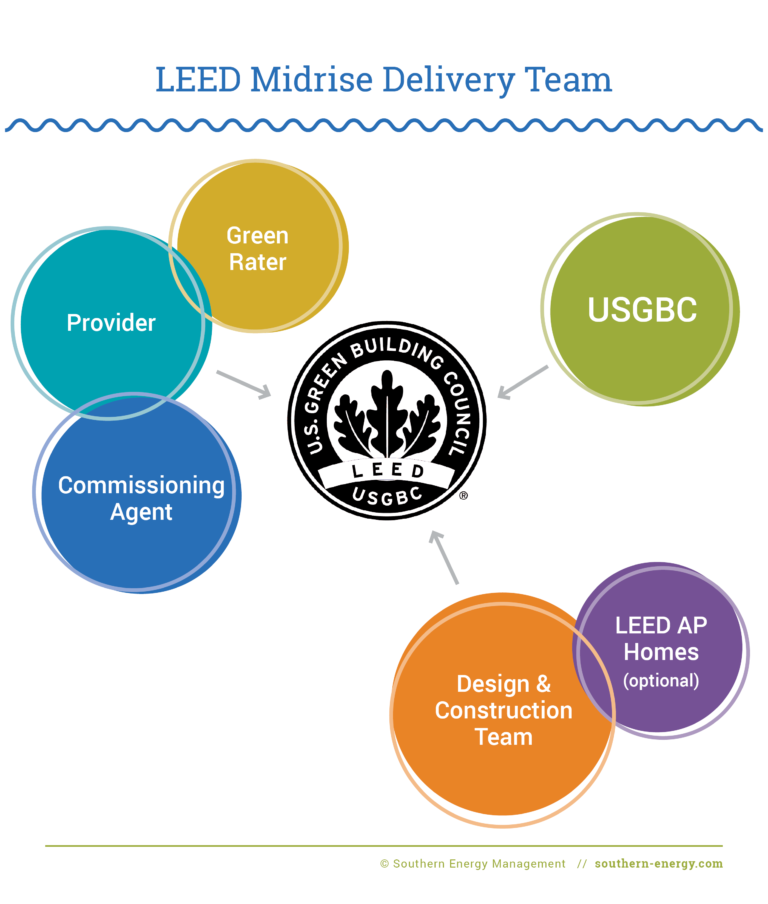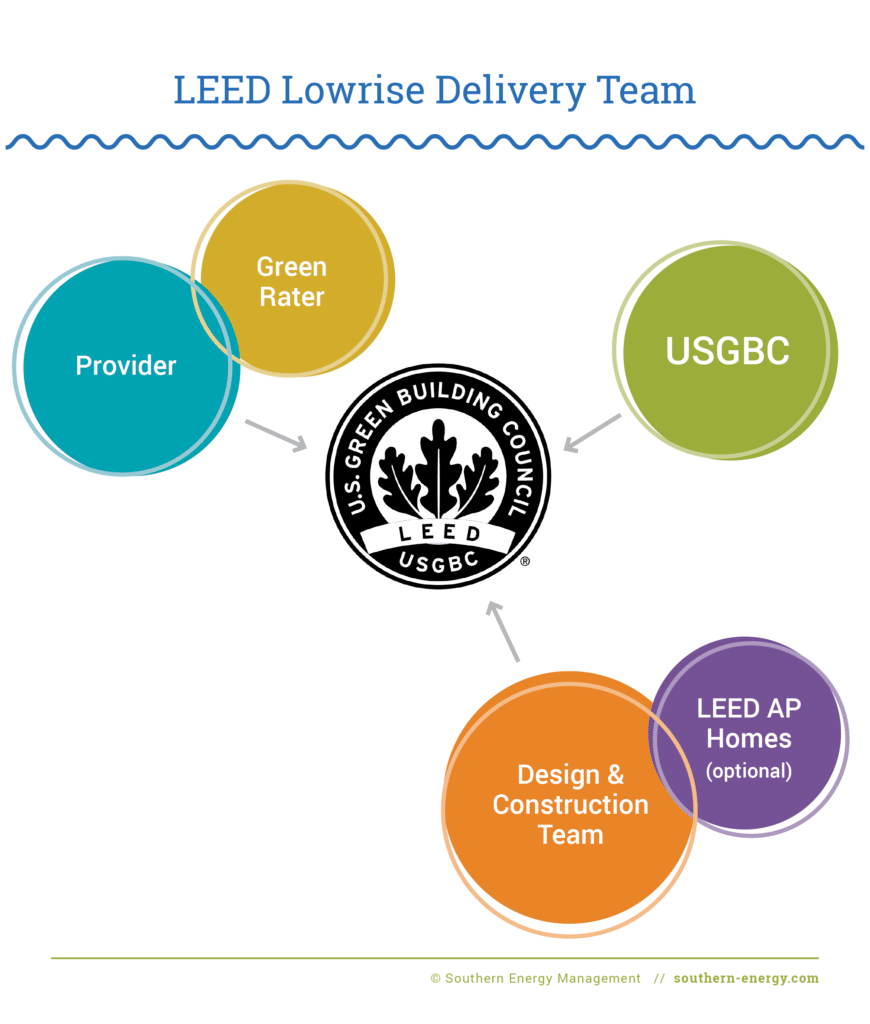LEED for Multifamily: Which Pathway is Right for You?
- Rachel Della Valle
- Jacob Hauser
- August 26, 2022
- 11 Minute Read


When we talk about green building with those who don’t live and breathe it like we do, LEED is often the first certification program that comes up. The Leadership in Energy and Environmental Design (LEED) program, which began development in 1993, is one of the most widely used and recognized rating systems for green building today.
In this article, we’ll help you understand the basics of LEED and the different pathways for certification specifically for multifamily projects.
The United States Green Building Council (USGBC) is the governing body that develops and interprets all of the official rules and regulations surrounding the LEED program.
The Green Building Certification Institute (GBCI) is responsible for implementing the USGBC’s framework by overseeing and managing the certification process. This means when a project team is working to certify their property, we, as the sustainability consultant, will be working directly with GBCI to accomplish their certification goal.
Depending on project specifications, there are three directions a new multifamily project can take to achieve LEED Certification — LEED New Construction (NC), LEED Multifamily Midrise, or LEED Multifamily Lowrise LEED NC is a pathway in the BD+C rating system, whereas LEED Multifamily Lowrise & Midrise are pathways in the Homes rating system.. Even if your project is already built, it’s never too late! LEED O+M offers a pathway to certification for many existing buildings.
LEED BD+C (Building Design and Construction) is the most inclusive and extensive rating system within the LEED program. It has been tailored to fit the following project types:
Although new multifamily projects can pursue either the BD+C or Homes rating systems, each pathway remains quite distinct from each other regarding the process of credit achievement, documentation, verification, and the relationships between the project team and GBCI. This section will focus upon the New Construction and Major Renovation project types.
New Construction & Major Renovation (LEED NC), is heavy on the documentation side of credit achievement. It has been developed to fit a variety of building types and is quite flexible – a true “one size fits all” rating system. However, being flexible and able to cater to various property types also makes it a difficult rating system for some properties, as not all credits will be specifically tailored to your property type.
When pursuing LEED NC, there are two major requirements that project teams should take note of: a Commissioning Agent (CxA) to ensure that the Owners’ Project Requirements (OPR) are met during and after construction, as well as an Energy Model of the property that demonstrates a percent energy reduction over ANSI/ASHRAE/IESNA Standard 90.1–2010.
It is imperative that the LEED AP and sustainability consultants are on the scene as early in the process as possible– ideally during conceptual design. LEED NC grants a “free” credit for project teams that engage a LEED Accredited Professional in Building Design and Construction (AP BD+C) on the project team. The LEED AP provides guidance to the project team on credit documentation and handles all of the LEED Online work that is required for the project.
Having a LEED AP in the loop early during design development can:
This will minimize unanticipated obstacles for the project team while helping to save on costs as changes in the beginning are much easier to make than further down the road.
LEED Homes is tailored toward the residential side of LEED, providing pathways for single-family homes, low-rise multi-family (one to three stories), or mid-rise multifamily (four or more).
LEED Multifamily Midrise was tailor-made for multifamily projects 4 to 8 stories in height. The Midrise program mirrors the New Construction program in that the whole building ASHRAE 90.1 2010 energy modeling is required and commissioning is required for central HVAC and water heating systems.
A major difference between LEED NC and the Homes pathways is how they are managed. The Midrise and Lowrise programs utilize LEEDH Providers and LEEDH Green Raters to carry out a majority of the program administration and oversight.
The Provider serves as the primary body on credit clarifications and quality assurance, while the Green Rater’s focus is credit selection, on-site verification of credits, and documentation collection. The project team works directly with a LEEDH Provider and/or Green Rater to select credits and provide documentation.
At the end of the project, the Provider will submit the project for certification to GBCI, which has the final review. While not required, it’s recommended to have a LEED Homes AP on a Midrise or Lowrise project. As noted above, this can afford the project a “free” credit.
Like LEED NC, documentation plays a major role, although performance testing a minimum of 15-20% of the residential units is required for the Midrise program. That percentage is based on a sampling protocol implemented by the Green Rater and/or HERS Rater on the project.
Performance testing includes two of the tests required for the Homes program: HVAC system leakage testing and compartmentalization (blower door), but has the added commissioning of central systems. The Midrise program’s commercial energy modeling and commissioning paired with the LEED for Homes Provider performing the program administration blends methodologies from both the BD+C and the Homes programs.

LEED Multifamily Lowrise (Homes) is the same program with the same scorecard as LEED Homes. As such, it was designed with single-family homes in mind. However, it can be implemented by a multifamily project up to 5 stories in height that have individual unit HVAC and water heating, and is at least 50% residential space.
The Lowrise program differs from the Midrise and NC programs in terms of energy modeling and performance testing. LEED for Homes requires residential energy modeling via a HERS Rating Index. This addresses the multifamily unit energy usage, but not the common areas or commercial spaces. This program also requires Energy Star V3.0 Certification for the residential units.
Lastly, the Homes program requires performance testing on a minimum of 15-20% of the residential units. This number is based on a sampling protocol implemented by the Green Rater and/or HERS Rater on the project. Performance testing includes but is not limited to HVAC system leakage testing, compartmentalization (blower door), ventilation systems, and room balancing. The performance testing requirements are more in-depth than the Midrise program and the focus is on the residential units. No common area or commercial systems are required to be tested.

LEED Registration and Certification fees depend upon the following parameters:
We are happy to help you choose a rating system that is best suited to your goals, budget, and your project’s details.
If you think choosing a multifamily LEED program is complicated, you’re not alone. There are many projects, especially in the Multifamily sector, that are eligible to pursue different versions of LEED based on their details.
As many of you may have experience with LEED 2009 (V3), LEED V4 continues to lift many of the qualifying requirements from the NC program, so that residential projects, 5 stories or less, are now able to select between potentially three rating systems. These systems all vary in price, rating details, and implementation. Reach out to us for more information and guidance on which rating system may be most ideal for your team.
Headss Up — LEED V4.1, the newest version of LEED, is available to LEED BD+C projects and LEED for Homes (Single-Family) projects. However, V4.1 is not available to Midrise and Lowrise Multifamily projects in the US or Canada, and USGBC has not revealed an expected release date.
Any project registered under V4 can substitute credits for its V4.1 counterpart. This means potentially more straightforward credit compliance for your project, especially if you’re having trouble with a particular credit.
LEED V4 is the current and most widely used version of LEED. LEED V4.1 (the latest version) is partially released, and is currently available to LEED BD+C projects and LEED for Homes (Single Family) projects. However, V4.1 is not available to Midrise and Lowrise Multifamily projects in the US or Canada. As of August 2022, USGBC has not revealed an expected release date.
LEED V4 was released in December 2013 and is available for all LEED projects today.
You can register for LEED V4 through LEED Online.
Credits can be earned through a variety of different green building practices such as Energy Efficiency, Water Efficiency and Indoor Environmental quality just to name a few. Contact one of Southern Energy Management’s LEED AP’s today to learn more about specific credits.
LEED V4 is a comprehensive green building program that ensures your building is efficient and environmentally conscious. It is a great way to get involved in the green building movement.
A LEED energy model requires a commercial ASHRAE 90.1 energy model with additional documentation and support for the GBCI review.
Any Commissioning Agent can commission a LEED V4 project
Outside of LEED AP consulting fees, and project certification fees, costs are very dependent on your project and its goals. For example, pursuing LEED Multifamily Lowrise will have lower costs associated with energy modeling & performance testing and there is no commissioning requirement. Whereas Midrise and BD+C require a whole-building commercial energy model as well as commissioning. Additionally, Midrise requires dwelling unit performance testing and on-site verification during construction.
Southern Energy Management has been an advocate for green building since we opened up shop in 2001. We are a proud USGBC member who stays active in the green building community – whether it’s a local chapter meeting or attending the annual Greenbuild International Conference and Expo.
We have in-house LEED Accredited Professionals (AP) and LEEDH Green Raters to walk you through program nuances and credit selection to ensure you’re on the best pathway for your project. Schedule a meeting to evaluate your project, or fill out the form below to request more info.
Schedule a meeting with our green building specialists to review your project goals and challenges.
North Carolina’s solar power and building performance expert. Founded in 2001, we’ve worked for 20+ years to improve the way people make and use energy.